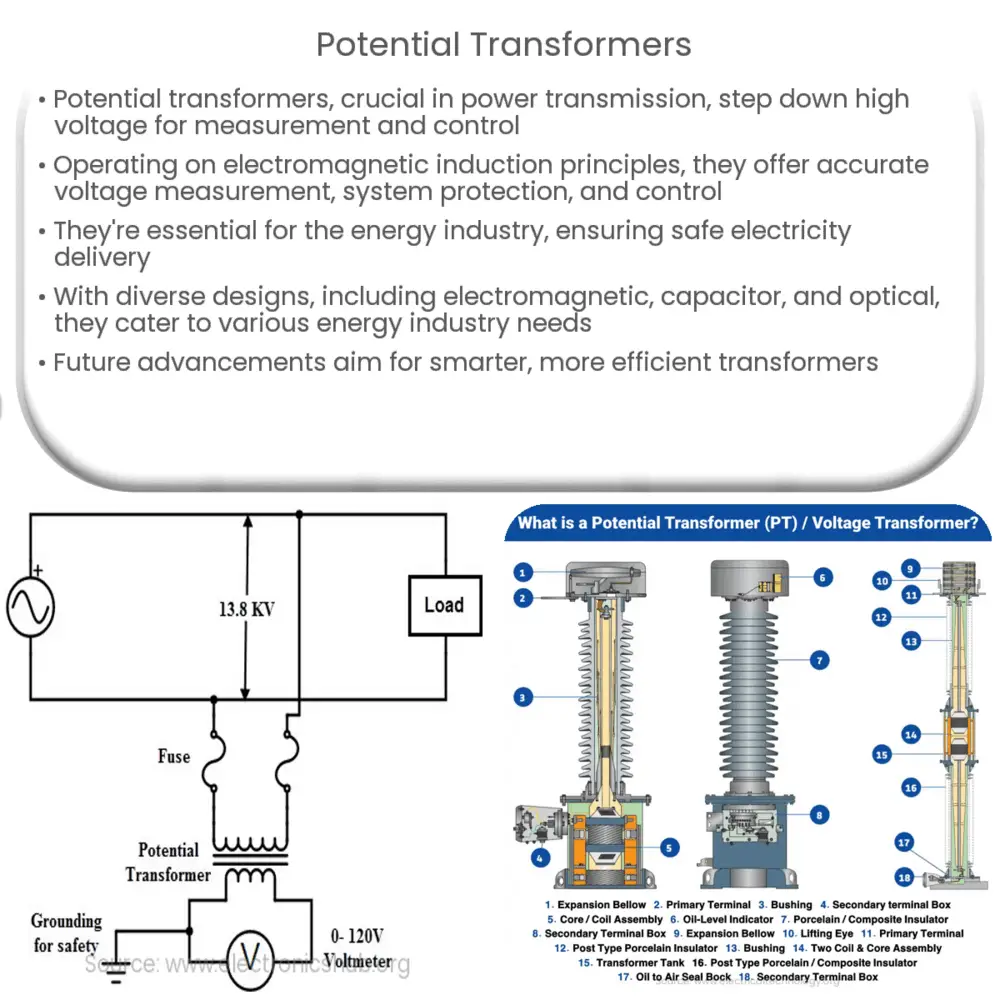Explore the role of potential transformers in power systems, their various types, applications, and future prospects in our detailed guide.

Potential Transformers: An Integral Component of Power Systems
Potential transformers, also known as voltage transformers, play a pivotal role in power transmission and distribution systems. Their primary function is to step-down high voltage levels to a safe magnitude that can be utilized for measurement and control in power systems. This article aims to explain the concept, applications, and importance of potential transformers in the energy industry.
Understanding Potential Transformers
Before delving deeper into the subject, it’s essential to understand the basic concept of a potential transformer. Like all transformers, potential transformers operate based on the principle of electromagnetic induction, discovered by Michael Faraday in 1831. They comprise two primary components: a primary winding connected to a high-voltage power source and a secondary winding that delivers a scaled-down voltage to the measurement devices.
Applications of Potential Transformers
- Measurement: Potential transformers enable accurate voltage measurement in high-voltage systems. The voltage level at the transformer’s primary side is stepped down to a level that conventional measuring instruments can handle safely. This makes it possible for engineers and technicians to monitor the system’s performance and make necessary adjustments.
- Protection: Aside from voltage measurement, potential transformers also provide critical protection to power systems. They facilitate the operation of protective relays that can detect faults in the system and initiate necessary corrective actions.
- Control: Potential transformers are crucial for maintaining control over power systems. They supply a low-voltage signal to control devices and regulators, which in turn regulate the system’s operation based on this input.
The Role of Potential Transformers in the Energy Industry
Potential transformers are indispensable to the energy industry. They ensure safe and efficient operation of power systems, thus playing a vital role in delivering electricity to homes, businesses, and industries. The need for reliable and accurate voltage measurements, system protection, and control has made potential transformers a cornerstone of modern power systems.
The Design and Types of Potential Transformers
Potential transformers come in various designs and types, each with its unique advantages and applications. The three main types are electromagnetic, capacitor, and optical potential transformers. These are designed to suit different operating conditions and requirements, making them versatile tools in power systems.
Electromagnetic Potential Transformers
Electromagnetic potential transformers, the most common type, use magnetic fields to convert high voltage to low voltage. This type of transformer is highly reliable and has a wide range of applications in the energy industry.
Capacitor Potential Transformers
Capacitor potential transformers employ capacitive voltage dividers to provide voltage scaling. These transformers are known for their compact size and high voltage handling capabilities, making them suitable for use in high-voltage transmission lines.
Optical Potential Transformers
Optical potential transformers are a relatively new development in transformer technology. They use optical sensors to measure voltage, eliminating the need for physical connections to high voltage systems. This feature significantly enhances safety and reduces the risk of electrical accidents. Furthermore, optical transformers are less susceptible to electromagnetic interference, providing more accurate measurements in areas with high electromagnetic noise.
Choosing the Right Potential Transformer
Selecting the right potential transformer is a critical decision that depends on several factors, including the voltage level, accuracy requirements, physical space, and budget. It’s essential to carefully evaluate the specific needs of your power system to choose the most suitable transformer.
The Future of Potential Transformers
As the demand for reliable and efficient power systems grows, potential transformers are expected to evolve. Advances in technology are leading to the development of smarter and more efficient transformers, capable of self-monitoring and predictive maintenance. These advancements will further enhance the reliability and efficiency of power systems, contributing to a more sustainable energy future.
Conclusion
In conclusion, potential transformers are a fundamental component of power systems. They play a crucial role in ensuring safe and efficient transmission and distribution of electricity. With various designs and types available, including electromagnetic, capacitor, and optical potential transformers, these devices cater to a wide range of requirements in the energy industry. As technology progresses, potential transformers are set to become even more integral to the operation and control of power systems. Thus, understanding their workings and applications is of paramount importance for anyone involved in the energy sector.

